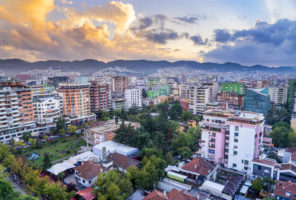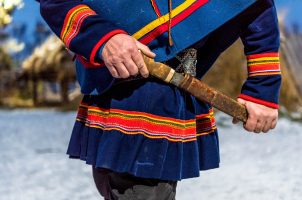Ad Free. Reader Funded.
Your contribution supports our partnership with the author of this piece. On top of their article pay, 50% of all contributions go directly to this journalist.
% of $ Goal
Total number of contributions so far:
0
Total amount raised for journalists
$0
“One thing I really appreciated about working with Hidden Compass is that it’s a space where there is time for nuance and complexity. By donating, that’s what you’re supporting. You’re able to help us as writers, but also as an outlet, continue to tell these kinds of stories.”
- Anna Polonyi, Hidden Compass Journalist
“The reason why I contributed was because the article that I read really resonated with what I was feeling. I felt like the author was in my head... It just moved me and I felt like I needed to do something.”
- Hidden Compass Reader
The gradient eases onto a stony outcrop. I survey an apocalyptic amphitheater below, as if from the observation deck of a 60-story building. Grayish fumes billow from a steaming yellow hillside. A motley squad of men in shoddy rubber boots and flip flops move in and out of dense, noxious smoke.
It is half past five and the early sunlight glances off the turquoise waters of a lake in the center of this hellish pit. A thick volley of gas drifts toward me — a warning not to be charmed by the lake’s beauty. This is Earth’s largest acid lake: With a pH level below 0.5, its placid waters are more caustic than battery acid. The stench overwhelms my nostrils, even through my gas mask.
As I peer into the abyss of Kawah Ijen — an active volcano rising some 9,000 feet above the island of East Java — I take in what must be one of the world’s most dangerous workplaces.
I have come here to bear witness to a crude mining operation. A couple hundred men from nearby villages congregate in the crater at the source of their prize — sulfur, the biblical brimstone credited with fueling hell’s fires — to hammer out a living amid toxic fumes that carry the risk of lung disease.
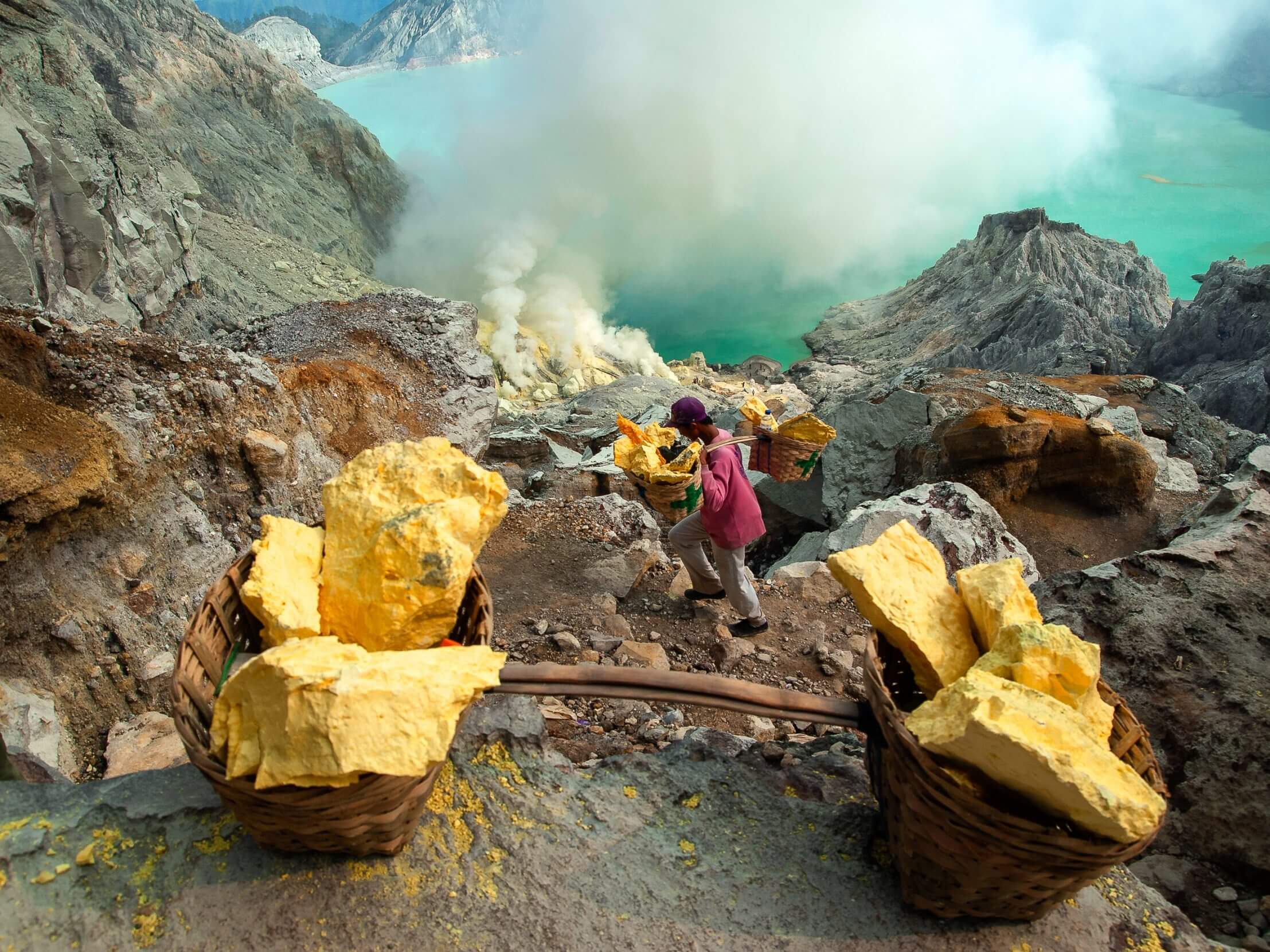
Baskets heaped with “devil’s gold” — sulfur — make their way to the rim of Kawah Ijen on the backs of Javanese miners, who must navigate precipitous terrain, toxic fumes, and the planet’s largest acid lake to earn their wages. Photo: Sugato Mukherjee.
It’s almost certainly the last place on the planet where mining this rich, reactive element relies on man instead of machine. The rest of the world harvests sulfur industrially — using a century-old process that pumps superheated water into underground deposits — or strips it out of oil and gasoline at processing plants.
Here on the Pacific Ring of Fire in Indonesia, Kawah Ijen remains a holdout for doing things the hard way.
~~
“Why is it still this way? Surely the sulfur deposits here could be harvested by mechanical installations?” I ask Bang Bang, my Javanese guide, between slurps of noodles.
Bang Bang had arrived at my Licin village hotel at 3 a.m. and insisted, after a 20-minute drive to the trailhead of the Ijen caldera, that we share a nocturnal meal.
“The mining company that operates here wanted to bring in machines in the mid-90s but faced stiff opposition from the miners, who feared they would lose their jobs,” Bang Bang says.
Across the dimly lit shanty, a small group of men finish their tea. I watch as they each carefully balance a large pair of baskets on their shoulders and stride into the inky oblivion before us.
They are miners headed to work, Bang Bang tells me. “This is the first of their daily, double trip to the crater. They start before dawn to avoid the stifling heat inside the crater that would get unbearable in a few hours.”
The toxic fumes churn unpredictably inside the crater.
We follow in their footsteps, setting off along a steep, winding road up to the volcano’s crater. Two shadowy figures jog past in the darkness. I can’t make out the details of their faces — lit only by the glow of cigarettes hanging from their mouths — but I’m struck by their skinny statures.
“Their bodies have adapted to the harsh environment, and the shoulder muscles have toughened over years of carrying those loads,” Bang Bang says as we eye more miners. “They can also hold their breath for a surprisingly long period of time when a volley of fume engulfs them inside the crater.”
Over the last four decades, more than 70 miners have died due to the sudden emission of highly-concentrated, poisonous gases.
The trail becomes narrower and steeper, and Bang Bang warns me not to veer to my right, where a sheer cliff drops several hundred feet. The vegetation changes; tall trees give way to stunted undergrowth and wispy bushes. A wind blows up and a strong, foul stench makes my eyes water and my nostrils burn.
“Hydrogen sulfide,” Bang Bang says. “This is another reason why the miners start in pre-dawn hours.” After sunrise, he says, erratic winds are common: “The toxic fumes churn unpredictably inside the crater.”
Periodically, huge quantities of sulfuric gases gush out of the hillsides and combust with the oxygen in the air. Had I been here earlier in the night, I might have spotted the otherworldly glow that results — and the crowds of tourists that flock here like moths to neon blue flames.
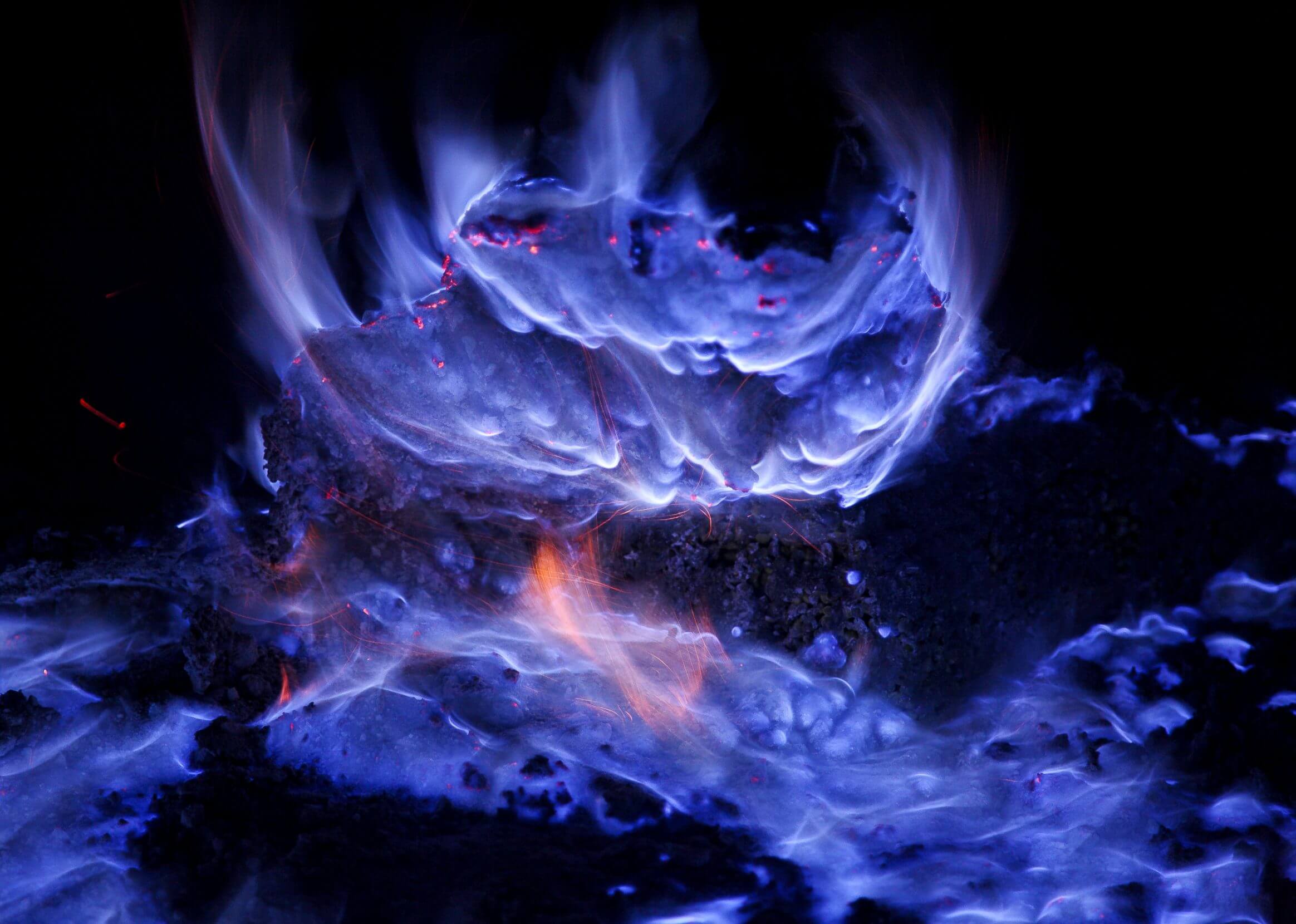
At Kawah Ijen, sulfuric gases emerge from volcanic cracks and combust upon contact with the air. The resulting blue flames glow in the night sky like lava flowing down the slopes. Photo: Martin Rietze / Alamy Stock Photo.
At the rim, the landscape becomes barren, the ochre ridge illuminated by the first rays of the sun. The wind has suddenly died down, the sulfurous smell bearable.
Bang Bang returns to my side with a small man of about 45. His name is Padi, and he will be my guide into the crater. Padi has worked these mines for 20 years; Once in a while, he takes a day off to lead the odd tourist to the crater floor.
The last decade has brought a surge of tourists to Kawah Ijen. During a typical high season, more than 1,000 spectators visit each day — and even more come on the weekends.
A signpost prohibits tourists from following the miners’ path into the volcano’s womb. Padi pays it no mind and leads me along the rough trail, half a mile or so among sheer precipices and loose stones. At times, I have to crouch down and balance myself on stony ledges. A few years ago, a French tourist fell and succumbed to the lake’s toxic waters.
The acrid smell of hydrogen sulfide intensifies. It mingles with another pungent gas — sulfur dioxide. I pull on the gas mask Bang Bang gave me as a parting gift. Most of the miners cover their faces with homespun scarves. Others use no protective gear at all. A gas mask is a luxury the miners can hardly afford. Padi tells me that masks slow momentum. They’re rarely used, even by those who possess them.
At a sharp turn, we wait as a long file of men slowly ascends from below. The mustard-yellow chunks of sulfur in their baskets gleam in the morning light. According to Padi, they usually take about an hour to climb from the lake to the rim. Seeing as they carry more than 150 pounds of sulfur on their shoulders, I find this to be amazingly fast.
One of the miners stops near me. I take out my pack of cigarettes and offer him one. He declines and points at my water bottle. I hand it over, and he takes a swig, smiling beforeresuming his upward grind. Some of his front teeth are missing. Years of exposure to these corrosive fumes dissolve the teeth, singe the eyes, and leave the skin crisscrossed with scars and burns.
~~
At the workstation at the foot of the crater, miners move in an orchestrated manner. In 1968, the local mining corporation installed ceramic pipes into the steep hillsides to funnel sulfuric gases emitted from fumaroles. Sulfur oozes out of the pipes red-hot and molten, then solidifies and turns golden-yellow. With rhythmic, dexterous hits, miners break off large chunks and fill their baskets, each doing his best to avoid breathing in the swirling gases.
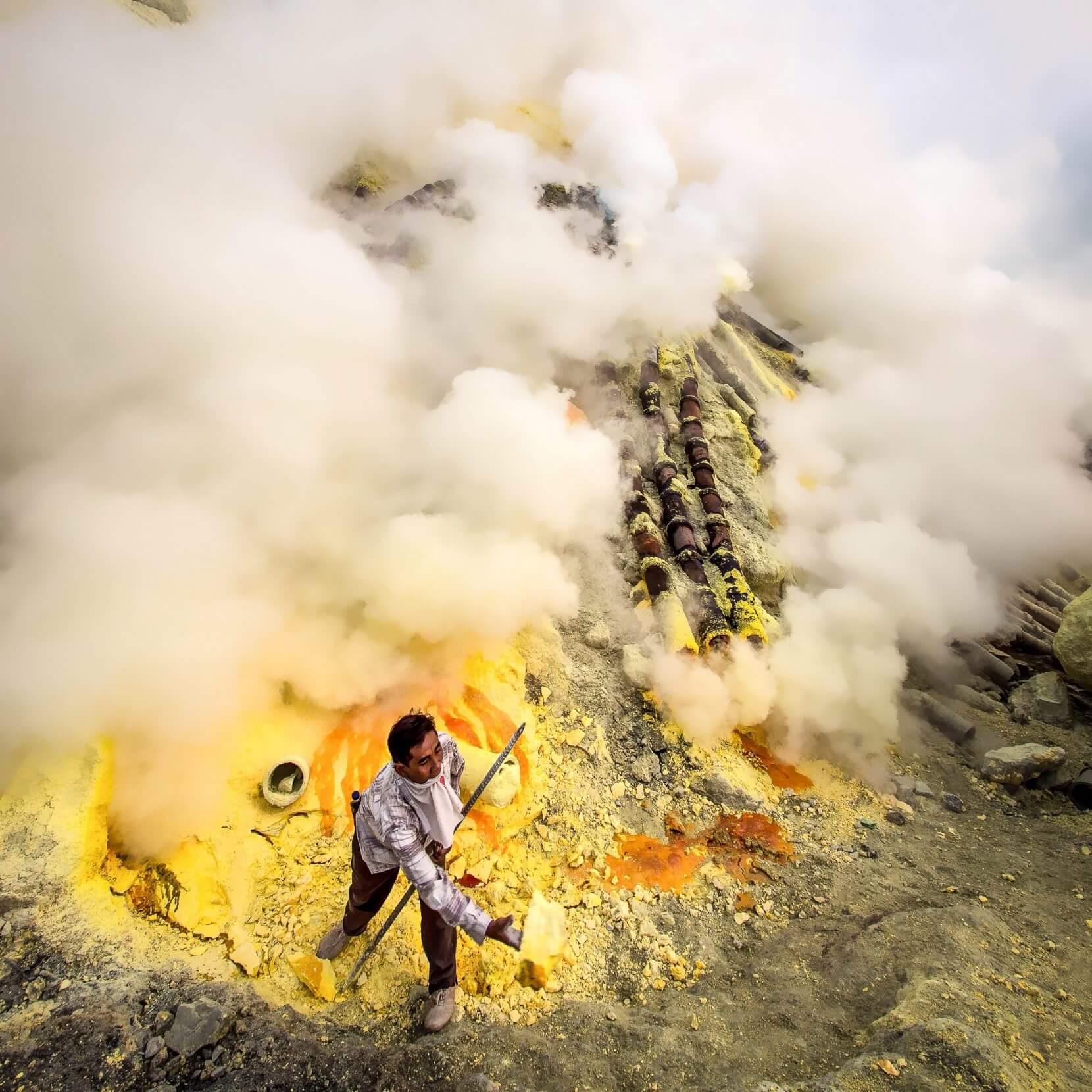
Working under a fog of fumes, a miner breaks off chunks of sulfur inside the caldera of Kawah Ijen. Sulfuric gas gushes down the slopes through pipes, oozing out red-hot before turning yellow as it cools into a solid. Photo: R.M. Nunes / Alamy Stock Photo.
As I watch, spellbound, a gust of wind blows in from the lake and suffocates me with smoke. For a couple of minutes, I stand still, fearful of moving on the treacherous terrain. I can see nothing except gray-white plumes and the distant silhouette of a miner gliding in and out of the veil like an apparition.
Then, I feel a tug on my left hand. Padi drags me into the sunshine and hands me a water bottle. My eyes sting; my windpipe feels violated.
I gulp down some water and look at my guide in gratitude. He nods and winks.
~~
Around 7 a.m., we begin the climb out of the caldera behind a group of miners. The man in front of me walks bare-bodied, sweating profusely. As he swiftly transfers his load to his other side, I glimpse his bulging shoulder. A reddish-brown patch covers the hyper-developed muscles — a callus.
“Every miner has this mark,” Padi explains casually. He moves his shirt collar to reveal a similar scar. “I don’t even feel the pain now.” He smiles and puffs his clove cigarette.
“Why did you leave your rice fields to work here as a miner?” I ask, having been told he started his life as a farmer.
With his income earned in this infernal workplace, supplemented by guiding services, Padi buys a better life for his family.
“Money,” he chuckles. A farmer in the rice fields of East Java earns the equivalent of around five U.S. dollars a day, he says, while a double trip inside the crater fetches him 10 to 12 dollars.
“I don’t want my two sons to be miners. I am sending them to schools,” Padi says. Two decades of lugging sulfur have bent his spine. Many of his mining friends are now dead. Even so, he insists he does not want the operations to change here, or to go back to being a farmer.
With his income earned in this infernal workplace, supplemented by guiding services, Padi buys a better life for his family. He knows this pecuniary leverage comes at a terrible price: poisoned lungs and, most likely, a shortened life. Researchers say prolonged exposure to this toxic environment leaves miners with an average life expectancy topping out around 50 years.
Still, Padi grins broadly. I wonder what his family thinks about his deadly profession, but I choose not to ask.
~~
At the weigh station below the rim, exhausted miners heave their loads onto a scale, earning 1,000 Indonesian rupiah — seven U.S. cents — for each kilogram of sulfur.
A few miners have stopped for a smoke break. A truck waits to take the day’s harvest to the nearby factory to be melted, then spread into thin sheets. Ultimately, it will find its way into matches and rubber, and will be used to bleach sugar and manufacture fertilizer.
On the other side of the rim, Bang Bang rejoins me, and we walk downhill over an asphalt track, passing a long file of domestic tourists on their way up. Several young boys laboriously push cushioned carts, with customers cocooned inside.
“We call them mountain taxis,” Bang Bang says. Entrepreneurial local lads operate these carts, he says, and a few miners, too. “It is easier to carry a passenger this way than to lug the heavy chunks of sulfur,” he adds. Their earnings rival a miner’s daily wages.
The long night behind me has already started to retreat into the recesses of my mind — a fog of strange beauty and horror.
The morning is pleasant and the hikers, many young boys and girls among them, seem to be in good spirits as they stream toward the rim.
Perhaps they embody an alternate pipeline to prosperity — one with more humane working conditions.
In this place of extremes — light and dark, chaos and order, hope and danger — a new outlook awaits. Though neither straight, nor devoid of risk, the path forward glistens in the brightness of the day.
Sugato Mukherjee
Sugato Mukherjee is a Kolkata, India-based photographer and writer whose work on the sulfur miners of East Java was recognized by UNESCO.
Never miss a story
Subscribe for new issue alerts.
By submitting this form, you consent to receive updates from Hidden Compass regarding new issues and other ongoing promotions such as workshop opportunities. Please refer to our Privacy Policy for more information.

